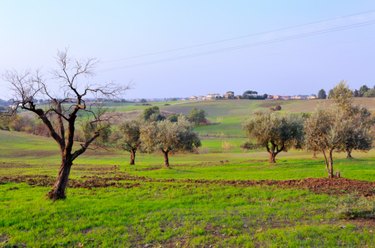
The olive tree, Olea europaea, is a small and very long-living species of tree found growing primarily in coastal Mediterranean regions. It was one of the first trees known to have been cultivated, having been grown for agricultural purposes in ancient Crete and Syria more than 5,000 years ago. The tree is most famous for its fruit and the oil produced from it. Among carpenters and furniture aficionados, however, the tree is just as famed for its high-quality wood.
Hardness and Grain
Video of the Day
Olive wood is hard, heavy and strong with a high overall density. It has a straight grain with a fine texture, says the Wood Zone website.
Video of the Day
Color
Due to its rich color and appearance, olive wood is a particularly sought-after material for use in decorative items. The wood contains brown streaks that contrast attractively with the lighter yellow streaks of the sapwood. Olive wood takes very well to polishing, and a fine luster can be achieved.
Odor
A distinct but not unpleasant odor adds to the overall character of olive wood. The wood's slightly sweet smell is particularly noticeable when freshly split or when worked with tools. Items made from olive wood will generally retain this faint aroma for many years.
Durability
The high natural durability of olive wood makes it ideal for furniture construction. However, it is moderately susceptible to termites and borers, says the Protabase website. If treated correctly and protected against parasites, olive wood furniture should last a long time.
Drying
Olive wood is not easy to dry. The wood is oily and dense, and material obtained from the tree's branches is prone to warping. Kiln-drying should be performed very slowly and at a low heat to prevent warping.
Working Properties
The high density and interlocked grain of olive wood makes it difficult to cut. According to The Wood Explorer website, general carving requires sharp cutting edges, and the wood should be well seasoned before use to avoid checks and warps in the final product. The wood can be turned and planed without major difficulties, but you should only use high-quality tools with sharp edges.
Lumber
According to the Architecturals website, olive wood is rarely sold or available as lumber. When it is sold, olive wood lumber is normally very expensive and cut into small pieces. The wood is often used to make small items, such as ornamental knife handles and jewelry boxes. Larger finished objects are scarce, highly desirable and expensive.